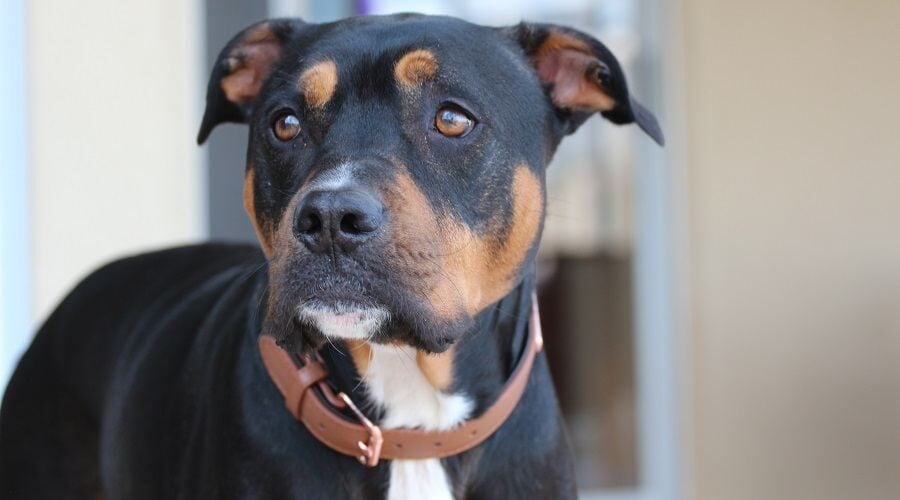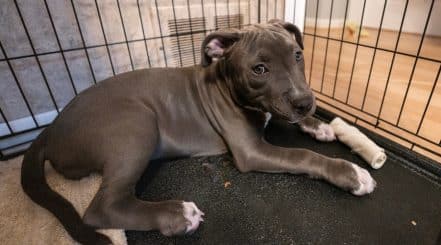Thinking of adopting a Rottweiler Pitbull mix? Despite once having a negative connotation as mutts, mixed breed dogs are on the rise. The Pitweiler, a cross between a Rottweiler and a Pitbull, is one such breed gaining popularity. While both parent breeds’ infamous reputation may give you pause, we can assure you that there’s plenty to love when it comes to the Pitweiler.
With the rise of mix breeds (especially APBT mixes), the Rottweiler Pitbull mix has become more popular. This mix is pretty common at shelters due to its Pitbull heritage. Many owners might stray away from this mixed breed because of the negative connotations surrounding Pitbulls and Rottweilers. However, there is more to this breed than meets the eye.
These breeds are very different but also have some striking similarities. In this article, we’ll delve into the truth behind the Rottweiler Pitbull mix and help you decide if this is the right dog for your family.
Parent Breeds
Before we break down all the relevant information about temperament, size, training, and more, it’s helpful to know about the Pitweiler’s parent breeds. Learning about both the Rottweiler and Pitbull will help you understand more about what to expect from this mixed breed.
Rottweiler

The Rottweiler is a large purebred dog historically used for herding and guarding cattle. It’s known for traits like alertness, discipline, and stamina, which have made the breed ideal for messenger duties and working as guard dogs. Even today, the Rottweiler’s smarts and endurance make it a favorite breed for things like support and search and rescue.
Of course, the Rottweiler’s physique has much to do with its suitability for these activities, as their muscular, sturdy frame is all strength. It’s a large dog that, when fully grown, ranges from anywhere from 100 pounds in females to 135 pounds in males.
The Rottie is easily identifiable, thanks to a characteristic almost all-black coat with rust-colored markings on the face, chest, and legs. It’s got a double-layered coat with a rough outside layer that protects from the elements and a soft inner coat for warmth. Rottie hair is short, straight, and glistening.
When it comes to personality, the breed is confident and courageous, yet somewhat standoffish with strangers. However, with family members, the story changes, and they are playful and silly and may behave like lap dogs. Although their tough exterior may give them a mean impression, they are not more aggressive than other dogs of the same size.
Pitbull

While it’s incredibly easy to conjure up an image of the Rottweiler prototype, Pitbulls are a rather different story. This breed is actually comprised of groups of dogs from several breeds, which is why it’s hard to think of just one Pitbull exemplar.
Its history originates in the 19th century, where Pitbulls were bred in England to create a tough fighting breed for pit and dogfighting. Bulldogs and terriers were the parent dogs, which resulted in a formidable mix. Pitbulls inherited the Bulldog’s fierceness and loyalty, along with the smarts and calculating personality of the Terrier.
It can be challenging to distinguish between the several Pitbull breeds in existence today, and to complicate matters further, the term is often used as a catchall for describing mixed dog breeds. However, it does have some characteristic physical features, and you can probably picture the square head and bulky, muscular body without a problem.
Pitbulls are generally medium-sized, though there is some room for variance. They come in a wide assortment of colors. They’re also short-nosed, making them susceptible to some health conditions that we’ll look at later.
Despite having an unwarranted reputation as a dangerous breed, a Pitbull has several wonderful characteristics when raised by a loving family. It’s a tenacious, courageous, and caring dog that loves to shower its family with lots of affection. Pitbulls enjoy people, and they make a fantastic family watchdog.
Rottweiler Pitbull Mix

Now that you know a little bit about the Pitweiler’s parent breeds, it’s time to take a look at what you can expect from this mix. It’s hard to pinpoint exactly when or why these two breeds were crossed, but the result is a spectacular combination of each. As you’ll see in the coming sections, the Pitweiler is quite an impressive dog. Its strongest asset is its ability to make an excellent watchdog, which is just one reason many families opt for this mix, unlike the rottie/lab mix which is usually less watchdog, more family companion.
But before we get down to business, we did want to mention that predicting the traits of a mixed breed can be difficult at best. This difficulty comes from the fact that not all mixed-breed dogs inherit traits equally from both parents. Sometimes, the pup takes after one parent much more than the other, so you can never be one hundred percent sure what you’re going to get. It’s vital to keep in mind that mixed breeds are an unpredictable mix of nature and nurture a lot of the time.
Temperament

Let’s start with one of the most critical aspects when considering adopting a dog: the temperament of the Pitweiler. Much like the pittie Labrador cross, we can say that they are playful, energetic dogs with lots of strength. It requires a great deal of physical activity (which we’ll discuss more below), and plenty of mental stimulation.
Pitweilers take after their Rottweiler parent in that they are rather aloof. They don’t tend to show interest in people that don’t form part of their family, though they won’t be aggressive towards non-family members. They aren’t big barkers either, only using their voice when there’s a reason to, which may be startling for anyone who doesn’t know their gentle nature.
Additionally, they’re highly loyal and devoted to their owners, but at the same time, they are independent and can fend for themselves. Pitweilers are laid-back and deal with unfamiliar situations with ease. One thing their owners like about them is that they don’t suffer from separation anxiety, so they make an ideal pet for families that aren’t home during the day.
One thing to keep in mind if you have other dogs is that this breed does best in a household with no other pets. Should you decide to add another canine to the mix, it should be the opposite sex. Additionally, because of the Pitweiler’s well-developed prey drive, it’s essential to keep an eye on them when around other small animals, such as cats.
Size & Appearance

As is typical with mixed breeds, size and appearance can vary considerably. You may find that your Pitweiler looks more like a Pitbull or more like a Rottweiler; sometimes, they inherit a healthy mix of both appearances.
Regardless of who they take after more, Pitweilers receive the powerful, muscular build characteristic of a Pitbull, plus the long legs and large head that Rottweilers are known to have. They’re also quite tall, which, combined with their muscular stature, makes this breed quite commanding. Pitweiler height ranges anywhere from 18 to 26 inches.
When it comes to weight, this number can vary widely, as well. Anywhere from 45 to 100 pounds when fully grown is expected, though you will consistently see heavier and larger males than females. Pitweilers also tend to have looser jowls than Rottweilers do, so keep in mind that drooling is a possibility.
Coat & Colors

Unlike with purebred dogs, predicting the color of mixed breeds can be quite challenging. This fact is especially true in the case of the Pitweiler, seeing as Pitbulls come in a range of colors. You can expect any number of colors from this mix. The most common colors include black, tan, brown, blue, fawn, and even white.
Pitweilers also sometimes have either merle or brindle patterning. Merle refers to a pattern of dots and dark-colored swirls over a lighter base color (such as in Australian shepherds), while brindle is a tiger stripe pattern over a brown base color.
Exercise & Living Conditions

By now, you’ve probably understood the idea that the Pitweiler is a powerful and naturally active dog. They require lots of daily exercise—at least an hour of physical activity, which translates to one walk per day, perhaps two. Owners should also be prepared for an additional half-hour of play to round things out. Pitweilers love games like fetch, tug of war, and rally. The pit-mastiff is a good choice if you aren’t up to the task of owning a more active dog.
Mental exercise is just as critical as physical exercise in keeping your pup happy and healthy. They’re highly intelligent animals, and they love having their smarts put to the test with toys designed for this purpose. Toys are also ideal for when you don’t have time to play with your dog. Just be sure you get one that is strong enough to withstand the Pitweiler’s formidable jaws.
Short obedience training sessions are another effective way to tire this breed. Even fifteen minutes at a time is sufficient. Similarly, you can keep them entertained by hiding food and treats around the house or handing them a Kong. However you engage them, Pitweilers lead happier lives when they have access to bigger living spaces and outdoor areas; apartment living isn’t for them.
A well-exercised Pitweiler is mellow and content to be inside without destroying anything. But they can well and truly make your life miserable if you fail to give them the stimulation they so desperately need, becoming too hyper and overexcited. Keep in mind that puppies often require even more exercise than adults do.
Training

At the start of the article, we mentioned that both Pitbulls and Rottweilers have high prey drives, or a motivation to chase, catch, and kill that’s typical in working dogs. In other words, they have an instinctual desire to chase things and may lose control when these urges kick in. When they see “prey” (such as small furry animals) moving, it triggers a dog’s natural chase response.
So what does having a high prey drive mean for training? Because it can make your dog unpredictable, it’s critical to establish control over them when they are off-leash. They must learn basic commands like “stay,” “leave it,” “watch me,” and “place” to help them with their impulse control. Inexperienced first-time owners may have difficulty teaching them these necessary skills, which is one reason this breed is not recommended for newbies.
The earlier training starts with this breed, the better, though slow and steady is the name of the game. Trying to go too fast may be counterproductive, especially when considering the Pitweiler’s independent nature. Going slowly helps build rapport with the owner and ensure success down the road. Otherwise, you may find yourself having difficulty controlling this muscular pet when he’s fully grown.
We recommend early leash training and road awareness for puppies, who should also be socialized from a young age. Pitweilers respond best to positive reinforcement and gradual reward-based training—they should never be challenged directly, punished for misbehaving, or yelled at. Clicker training is another effective method for Pitweilers.
Health

While Pitweilers are generally healthy. They will generally live until they are 10-13 years old. However, there are some health risks to be aware of. Making sure you’ve done your due diligence with both parents is something we always recommend if possible. That will help rule out any of the potential conditions below.
Hip Dysplasia: You’ve likely heard of hip dysplasia. This is a condition that many large dog breeds are prone to suffering. Hip dysplasia is when the dog’s hip joint does not form properly, making it impossible for the leg bone to attach to the joint as it should. This problem leads to unusual wear and tear, such as arthritis, stiffness, pain, and sometimes lameness.
Cataracts: Both Rottweilers and Pitbulls suffer from eye issues, in particular cataracts. Cataracts are when the lens of the eye clouds and prevents light from reaching the retina, which leads to blindness. Regular checkups with the vet are imperative to keeping your dog’s eyes healthy and avoiding surgeries.
Bloat: While bloat is not particular to the Pitweiler breed, it poses a severe health threat nonetheless—and it’s all too easy to fall victim to it. Bloat is a dangerous buildup of gas that occurs when a dog exercises right after eating or drinking large quantities. It causes their stomach to enlarge and twist, and it can result in death.
Nutrition

The Pitweiler is a large dog, and its nutrition should reflect this large size. It’s best to split mealtimes in twice-daily feedings, though three may be better for some dogs. Regardless of how many meals your dog eats per day, you should always wait at least an hour after feeding to exercise them. This time should allow for adequate digestion to avoid the bloat issue we mentioned in the previous section.
Calorie requirements for Pitweilers range from between 1000 to 2000 calories per day, and it may change based on things like age, activity level, and the season. In general, this breed has a high protein requirement, especially when they’re puppies. Around 2.62g of protein per kg of body weight is ideal. If you notice your Pitweiler gaining weight, we recommend consulting your vet to find the right nutrition plan for your dog.
Grooming

For pet owners looking for a dog that’s low-maintenance when it comes to grooming, the Pitweiler is an ideal candidate. In most cases, this breed won’t require as much professional grooming as many other mixed breeds do. The exception would be if you are uncomfortable clipping your dog’s nails. This task should be done every month, and some dog owners prefer to have a professional do it.
Otherwise, the short coat that the Pitweiler inherits from both parent breeds is good news for anyone who prefers to invest little effort in grooming. It requires very minimal brushing once or twice per week. If your dog has a longer or medium-length coat, they’ll need more brushing. Even so, it’s nothing excessive. Typically Pitweilers are more known for taking after their Pitbull parent’s single coat, making them year round shedders.
Pitweilers don’t have a particularly weather-resistant coat like some other breeds. You won’t have to bathe them all the time, either. Once every few months is sufficient, and your nose will be a good indicator that the time has come. If you prefer, you can bathe them with special shampoos formulated to both clean the dog and protect against fleas. Finally, you should make sure to brush your dog’s teeth three to four times per week to maintain their oral health.
Breeders & Puppy Costs

It’s difficult to specify the exact cost of buying a Pitweiler from a breeder—price will depend on factors such as location, breeder reputation, and more. But in general, expect to pay anywhere from $500 and up depending on where you’ve adopted from.
Rescues & Shelters

Aside from breeders, it may also be possible to find Pitweilers in shelters, as well. The upside to adopting from a shelter is that you will spend considerably less money than if you buy from a breeder. The downside is that you will have to wait until the shelter has this breed, which is never a guarantee.
Additionally, there are some risks to consider when adopting from a shelter or rescue center. The dog may have ended up there for many reasons, most of which are generally serious—things like abuse, neglect, and personality issues may have contributed to the dog being placed in a shelter.
Because these problems can have long-lasting effects, if you’re considering a shelter dog, we recommend finding out as much as you can about why they ended up there. It’s best to know what you’re getting yourself into, and whether you can handle it. You want to know this before taking one of these dogs home.
As Family Pets
- The Pitweiler is a playful dog that loves to spend time with you
- He makes a very loyal companion that will show little interest in non-family members
- He is loving and affectionate but may not recognize that he is not a lap dog
- The Pitweiler enjoys the company of people but is okay with being left alone
- He is excellent with children but may be too boisterous for tiny kids
- The Pitweiler tends to run into things, so take care around older adults
- He makes an ideal watchdog
Final Thoughts
Despite having a formidable appearance, we could say that the Pitweiler is actually a gentle giant. This active and energetic breed makes a loyal companion that will protect both you and your children—as long as it’s placed in the right home.
First-time dog owners are not the best candidates for this breed, as it needs a firm hand with proper training and strict rules. The same goes for anyone with young children or small spaces; Pitweilers flourish in households with lots of space and active owners who can give them the stimulation they need. Pitweilers can make wonderful family companions for the right home.






I’m looking for a rottweiler and bullmastiff mix puppy..my husband and I had a female, she was the Smartest and most best dog ever..we lost her Aug 3rd 2023, she got ran over in the hwy, we really want another one, we prefer a female if anyone knows of any please let me know thank you
Looking for pit Rottweiler mix puppy
I have a pitweiler, about one year old. He has very defined muscles, also has a problem with keeping proteins in his body so it makes him eat stuff that is not food. He has had surgery to get a teddy bear removed from his stomach, he is always eating things. Which is a sign of pica, this website was very helpful.
Pls what is the ideal breed to Mate a Female Pitweiller with
We recently lost our dog of 11 years and believe he was a Rottie/Pit mix. Awesome dog! I was not aware of this Pitweiler breed and would absolutely love to find a breeder or somewhere that I can get a puppy. After having that dog, the Pitweiler breed would be my pick. I am in the Charlotte, NC area.
Hi
Did you get a dog yet?
Contact me
I have 2 Females and 3 Males still available. They will be ready for their forever home the last week of June. Please message me for additional information if interested.
Hi. My wife was given a pitweiller as a birthday gift from our son, personally chosen by him. We already have a jack russell, a fox terrier and a cross between a husky and alsatian. Our pitweiller was getting along fine with the other dogs until he probably realized that he is stronger and bigger than the other dogs.
Him being a male and the fox terrier also a male. Well just politely told the fox terrier in his doggy manner that there is a new sheriff in town now. I have started to take him for his long walks and he has become a lot calmer now and doesn’t show his dominance towards the fox terrier. He has become a lot more tolerant of the other male dog.
I take him for walks on a short leash because I have better control pver especially when we by pass other dogs on these walks. If you could share a few more tips would be greatly appreciated.
Hi Vernon, firstly, thanks for sharing your experience with your new pup. Sounds like a great dog! Regarding some tips, I’d recommend checking out some of the videos and other training content we have on the site. We have some content specifically about obedience training and basic commands. It sounds like you are on the right track, though. An exercised pup is much easier to train.
I would also recommend walking your dogs together consistently. Take your Pitweiler for his walk first to tire him out. Then walk with both dogs. This will help grow their bond. Stay patient, and continue correcting the behavior. You should also reward the behavior you do want. So when there’s a pleasant interaction between your dogs, use a high value reward. If you can’t seem to get them to get along, I’d recommend investing in a trainer locally and in-person. Good luck with your pup!
I just got a mix of a pit bull and a Rottweiler with a little bit of retriever and I have no idea what to expect so I really appreciated your article. I’ve had experience with many breeds of dogs that I loved their whole life they were everything to me. I’m hoping I can do this with beautiful little baby Sadie Leigh.
I was misled about her age so I’ve had to deal with a very young puppy, formula, and the like! She is very intelligent and learns well I’m just concerned I can’t teach her what her mother would, any advice would be much appreciated.
Hi Tami! Make sure to give your puppy some time to get adjusted. It can take time for them to settle in and mature. As long as you are consistent with your training and don’t reward bad behaviors, you should be good to go. If you need any advice about basic obedience tips, feel free to search the site as we have many. I would also recommend contacting a local trainer in your area for best results. Good luck!
I have a Pitweiler that I’ve had since he was about four weeks old when my friend’s mother’s dog quit feeding them. He is 10 weeks old right now and he is just a bundle of joy. He plays with my blue heeler and they are the best of friends.
I exercised him all the time. He’s good on the leash he’s really intelligent and has really learned a lot in his short little lifespan. You have one thing right – he’s a big old lap dog! He wants to crawl all over me. I am in a wheelchair we are going to be training him to be a wheelchair service dog. Wish us luck with sir Splatteus Maximus!
Sounds like an amazing dog, Theodore! Thanks for taking the time to stop by and share your story about your pup!
Wonderful explanation of this beautiful dog. I am waiting on mine, 2 weeks left with mom. I’m very excited to get him. I am experienced with all types of dogs. I had a Jack Russell Terrier for 14 years he recently passed and I’m now ready for a different but similar breed.
As far as activity, exercise, and training. He was the light of my life. We spend day and night together 24/7. He was well mannered and trained by me. I’m so excited to get this breed of dog. He will be loved and trained to be the best dog he can be.
Thank you for all the information you have given me. I will be back with a story and pictures of my new best friend. I’ve been working on names for him. I want a strong but different name. I will know once I meet him. So excited!! Thanks again!
Thank you, Sandy! Glad you found the article useful! I’m sure you will love this mix and do just fine with your new pup! Good luck!